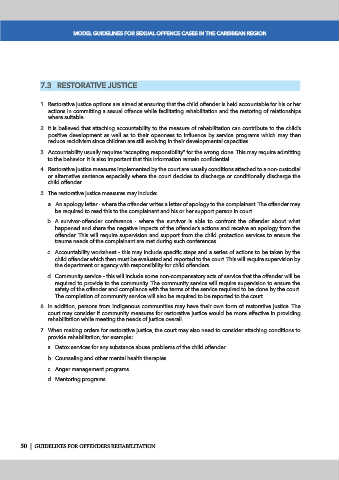Page 650 - Magistrates Conference 2019
P. 650
MODEL GUIDELINES FOR SEXUAL OFFENCE CASES IN THE CARIBBEAN REGION
7.3 RESTORATIVE JUSTICE
1. Restorative justice options are aimed at ensuring that the child offender is held accountable for his or her
actions in committing a sexual offence while facilitating rehabilitation and the restoring of relationships
where suitable.
2. It is believed that attaching accountability to the measure of rehabilitation can contribute to the child’s
positive development as well as to their openness to influence by service programs which may then
reduce recidivism since children are still evolving in their developmental capacities.
3. Accountability usually requires “accepting responsibility” for the wrong done. This may require admitting
to the behavior. It is also important that this information remain confidential.
4. Restorative justice measures implemented by the court are usually conditions attached to a non-custodial
or alternative sentence especially where the court decides to discharge or conditionally discharge the
child offender.
5. The restorative justice measures may include:
a. An apology letter - where the offender writes a letter of apology to the complainant. The offender may
be required to read this to the complainant and his or her support person in court.
b. A survivor-offender conference - where the survivor is able to confront the offender about what
happened and share the negative impacts of the offender’s actions and receive an apology from the
offender. This will require supervision and support from the child protection services to ensure the
trauma needs of the complainant are met during such conferences.
c. Accountability worksheet – this may include specific steps and a series of actions to be taken by the
child offender which then must be evaluated and reported to the court. This will require supervision by
the department or agency with responsibility for child offenders.
d. Community service – this will include some non-compensatory acts of service that the offender will be
required to provide to the community. The community service will require supervision to ensure the
safety of the offender and compliance with the terms of the service required to be done by the court.
The completion of community service will also be required to be reported to the court.
6. In addition, persons from indigenous communities may have their own form of restorative justice. The
court may consider if community measures for restorative justice would be more effective in providing
rehabilitation while meeting the needs of justice overall.
7. When making orders for restorative justice, the court may also need to consider attaching conditions to
provide rehabilitation, for example:
a. Detox services for any substance abuse problems of the child offender.
b. Counseling and other mental health therapies.
c. Anger management programs.
d. Mentoring programs.
50 | GUIDELINES FOR OFFENDERS REHABILITATION

